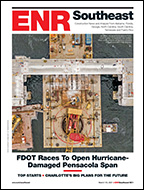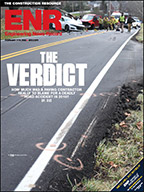Emergency Repairs for Bay Bridge Following Fatal Aug. 10 Crash
 MTA |
A span of the Maryland's Chesapeake Bay Bridge is undergoing emergency repairs following an investigation that uncovered flaws in its Jersey walls, and more reconstruction could follow. Several parapets on the 4.3-mile eastbound span of the double-span bridge were damaged during a fatal accident Aug. 10 that involved an 18-wheeler and two cars. The truck struck a parapet, knocking a portion of it off the bridge. The truck then skidded more than 100 ft along the wall before rolling into the bay. The truck driver died in the crash.
Radar inspections revealed small voids near the cores of the broken parapets, said Geoffrey Kolberg, chief engineer at the Maryland Transportation Authority.
"The front faces looked great and about 4 inches in there was dense solid concrete, but when you got about 12 inches toward the center, there was not good consolidation with the concrete," he said.
The slip-formed parapets were built during a 1986 reconstruction project on the 56-year-old bridge. Kolberg said the slip-form process is "one of the elements we're looking really closely at."
The discovery led to radar inspection of similar parapets that line approximately 9,000 ft of the bridge's two beam-span sections, which are located closest to each shore. Following test results of the southeast and southwest walls, MTA is retrofitting those portions. Tests of the northeast and northwest walls are ongoing.
The retrofit plan calls for adding new steel brackets that would bolt each parapet to the bridge deck along the edge that faces traffic. Additionally, a double "W" beam guardrail will be added to help with load share. The existing system uses U-bolts to attach the bottom of each parapet through the concrete bridge deck to a steel plate below the deck.
"We're going belt and suspenders on this," Kolberg said.
The project could cost up to $3 million and take 10 weeks to complete, if every parapet needs to be retrofitted. The Six-M Company of Delta, Pa., which is MTA's on-call contractor for emergency repairs, is the lead contractor. Wilton Corp. of Finksburg, Md., is fabricating the steel brackets. L.S. Lee of York, Pa., is installing the guardrail. The project will be funded using MTA emergency reserves.
In the meantime, MTA with consultants Amman & Whitney and URS Corp. are looking into more permanent solutions. Kolberg said MTA is looking at designs that would core into each barrier and reattach it through the deck, as well as a load distribution system, possibly a post-tension cable system, on the back face of each parapet away from traffic. The height of the barriers could also be raised.
Independent teams conduct visual hands-on inspections of the Chesapeake Bay Bridge annually. The latest inspection was completed in June. Kolberg said the issues uncovered with radar testing were not visually noticeable and could not be detected with ultrasonic testing.
The National Transportation Safety Board is also investigating the incident to determine if it could have implications with other structures nationwide, Kolberg said.
The accident occurred during contraflow, which changed circulation from two-lane one-way traffic to one-lane opposing traffic. MTA uses contraflow to offset heavy traffic to and from local beaches as well as during construction on the bridge. The bridge's westbound span has been undergoing a late-night re-decking project, however work has been suspended until the retrofit project is completed. All retrofitting will be done from the bridge deck and will require closure of one lane.




